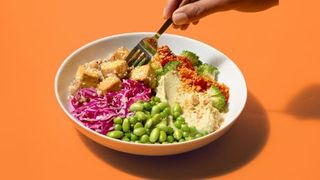The Tastiest Ways To Prepare More Plant-Based Meals
Some simple and delicious ways to up your fruit and veg intake

Interest in plant-based diets has boomed in recent years. Whether driven by ethical or health concerns, many people are looking to reduce their intake of meat and animal products and boost the amount of fruit, vegetables and pulses in their diets. Veganuary reported a record 500,000 sign-ups in 2021, an increase of 100,000 from 2020 and double that of 2019. Of this year’s sign-ups, 125,000 participants were based in the UK.
But for habitual consumers of meat, cheese and eggs, early experiments in plant-based meals can be a challenge. New cooking techniques can be hard to master all in one go, and after a few bland salads or tasteless heaps of boiled veg, you might find yourself dreaming of steaks and bacon, rather than focussing on increasing the number of plant-based meals in your week.
Mail-order meal services like allplants are a great, convenient way of getting a variety of delicious, nutritious, meat- and dairy-free food into your diet without having to memorise recipes or slave over a stove. But if you’re up to the challenge of preparing your own food, we have some tips to help fill beginners’ tables with plant-based food bursting with flavour that will leave you counting the hours until your next meal.
Choose your ingredients with care
The quality of your ingredients can, unsurprisingly, have a big impact on the tastiness of your meals. If you are finding your plant-based meals uninspiring, then consider splashing out on fresh and higher-quality ingredients. In many cases, organic produce and ingredients without lots of preservatives and added sugar can help you achieve a richer flavour.
The world of fruit and veg also offers an unmatched opportunity to experiment and try new things. With so many varieties and variations to choose from, consider stepping outside your comfort zone and trying something new like a funky mushroom or colourful squash. You might discover a new favourite.
Spice things up
Herbs and spices are famously a source of flavours that can be combined and experimented with endlessly to create delicious meals, from sprinkling them on roasting veg to mixing them into sauces. Supermarkets carry them in plentiful supply, and if you find particular spices that work for you, they can be bought cheaply and in bulk in many local convenience stores.
Many vegan cooks swear by nutritional yeast in particular for its cheesy, nutty flavour – it works as a great parmesan substitute. For the green-fingered, herbs can be easily grown on a windowsill, so a burst of fresh flavour is always within easy reach.
Books like the staple Flavour Thesaurus can be a great guide for pairing spices and herbs with vegetables and other foods, and there’s much joy to be found in playing around with flavours and finding the ones you like best.
Explore the world

Consider taking advantage of some culinary expertise that has stood the test of time. There are many cuisines from across the world in which vegetables play a major role, and these can serve as a great inspiration for your plant-based cooking. From Mexico to Greece, India and beyond, there are countless beloved dishes that can be replicated and adapted. Exploring international cuisine is a good way of learning to combine ingredients and flavours in ways you might not have considered, and to increase your repertoire of recipes.
Equally, allplants’ menu of over 30 mains draws on flavours, ingredients and dishes from all over the world, giving you plenty of chances to work out what you enjoy the most and incorporate it into your repertoire.
Don’t fear salt
We’re primed to be wary of consuming too much salt, but the reality is that you would have to add a lot to your food to get it anywhere near to the levels of processed foods or the average supermarket ready meal. A plant-based meal prepared with no salt at all can be very bland, and just a small amount can make all the difference.
Salt helps to enhance the flavour and reduce the bitterness of vegetables. In cooking, it also assists in breaking down pectins to soften your vegetables and make them more deliciously tender. If your plant-based meals are missing something, adding a pinch of salt is a simple way to start.
Fatty flavours
While much focus is given to meat and dairy as a source of protein (and the ways to compensate for this in a plant-based diet), the source of much of their flavour is in their fat content. Fruit and vegetables tend to contain a lot less fat, so if you want to make sure that your meals are both satisfying your hunger and bursting with flavour you will need to choose the right ingredients.
Fortunately, there are plenty of delicious sources of fat that you can incorporate into your meals. Nuts and seeds are a popular source of healthy fats, as are avocados and olives. Dressing your meals with a good-quality olive or coconut oil is another easy way to add delicious fat to your food, as are sauces that incorporate peanut butter or tahini (a paste made from sesame seeds that is a key ingredient of houmous).
When you need a break from cooking, allplants is a great option. Its meals are designed by nutritionists and prepared fresh by a team of chefs in its London kitchen. Delivered in 48 hours, meals can be heated from frozen and ready to eat in as little as six minutes. On top of this, the sustainable packaging (recyclable or made from recycled materials) can be returned for free so that allplants can recycle it. Services like allplants offer a simple, easy and quick way to get more delicious, plant-based meals into your diet while teaching you about flavours, ingredients and techniques you can incorporate into your own cooking.
Visit allplants.com to get started with £10 off your first delivery – use code COACHMAG at checkout*
*Discount applies to first order only, one use per customer. Offer expires 31.12.21 and cannot be used in conjunction with any other offer.
Get the Coach Newsletter
Sign up for workout ideas, training advice, reviews of the latest gear and more.
Coach is a health and fitness title. This byline is used for posting sponsored content, book extracts and the like. It is also used as a placeholder for articles published a long time ago when the original author is unclear. You can find out more about this publication and find the contact details of the editorial team on the About Us page.

